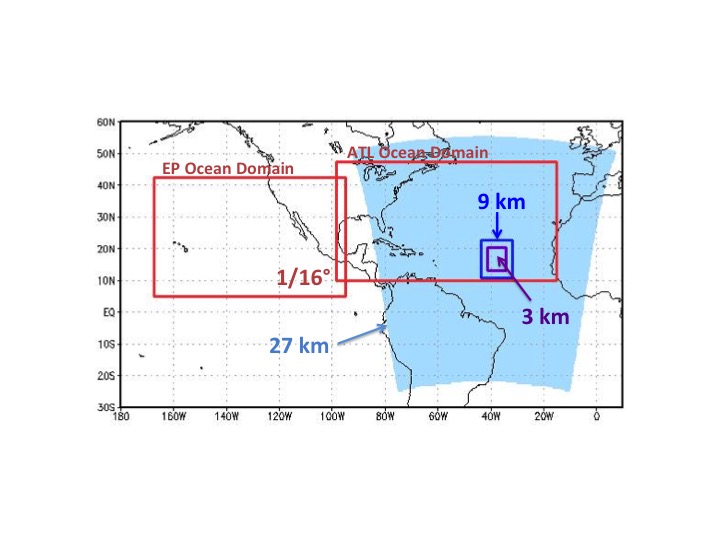HWRF HDRF/HDGF Forecast Comparison

HDRF/HDGF Forecast Comparison
- Code
- Models
- Domain
- Cases
- Verification
Codes Employed
The software packages used in the HWRF HDRF/HDGF Forecast Comparison Test were obtained from the HWRF code repository hosted by the Developmental Testbed Center. The code has been updated with respect to the HWRF v3.6a release in September 2014 with the addition of the partial cloudiness parameterization and with a change in effective radii of cloud particles in the RRTMG parameterization. The experimental configuration (HDRF) makes use of these changes, while the control configuration (HDGF) is very similar to the 2014 operational HWRF configuration and to the HWRF v3.6a released in September 2014.
The code repositories are:• HWRF (scripts and namelists): http://svn-dtc-hwrf.cgd.ucar.edu
• WRF: http://svn-wrf-model.cgd.ucar.edu
• WPS: http://svn-wrf-wps.cgd.ucar.edu
• UPP: http://svn-dtc-unifiedpostproc.cgd.ucar.edu
• GSI: https://gsi.fsl.noaa.gov/svn/comgsi
• HWRF-utilities: http://svn-dtc-hwrf-utilities.cgd.ucar.edu
• Princeton Ocean Model for TCs: http://svn-dtc-pomtc.cgd.ucar.edu
• NCEP Coupler: http://svn-dtc-ncep-coupler.cgd.ucar.edu
• GFDL Vortex Tracker: http://svn-dtc-gfdl-vortextracker.cgd.ucar.edu
The branches and revisions for the HDGF configuration are:
• WRF: branches/HDGF r 7819
• WPS: branches/HDGF r 875
• UPP: branches/HDGF r 605
• GSI: trunk r 1367
• HWRF-utilities: /branches/HDGF r 1109
• Princeton Ocean Model for Tropical Cyclones: branches/HDGF r 311
• NCEP Coupler: branches/HDGF r 182
• GFDL branches/HDGF r 236
The revisions for the HDRF configuration are:
• WRF: branches/HDRF r 7878
• WPS: branches/HDRF r875
• UPP: branches/HDRF r605
• GSI: trunk r 1367
• HWRF-utilities: branches/HDRF r 1109
• Princeton Ocean Model for Tropical Cyclones: branches/HDRF r 311
• NCEP Coupler: branches/HDRF r 182
• GFDL Vortex Tracker: branches/HDRF r 236
HWRF Model: HDGF Configuration
Configuration similar to the 2014 operational HWRF. Employs the GFDL radiation parameterization invoked hourly and no partial cloudiness parameterization. Other parameterizations used include Ferrier microphysics, SAS convection, GFS planetary boundary layer, and GFDL surface layer.
HWRF Model: HDRF Configuration
Configuration similar to HDGF, except for employing the RRTMG radiation parameterization (invoked quarter-hourly) and including a partial cloudiness parameterization.
Domain Configuration
The HWRF domain was configured in a similar way as the 2014 NCEP/EMC operational system. The atmospheric model employed a parent and two movable nested grids. The parent grid covered an 80 x80 degrees area with approximately 27 km horizontal grid spacing. The d02 domain covered an 11 x 10 degrees area with approximately 9 km grid spacing. The d03 domain covered a 7.2 x 6.5 degrees area with approximately 3 km grid spacing.
The location of the parent and nests as well as the pole of the projection varied from run to run and were dictated by the location of the storm at the time of initialization.
As in the operational configuration, HWRF was run coupled to the three-dimensional POM-TC model, which used approximately 9 km grid spacing. The Atlantic or Eastern North Pacific domain
of the POM-TC model was chosen depending on which basin the storm was is.

Click on the image to enlarge
Cases Run
• Storms: 18 storms from the 2011-2014 seasons.
• North Atlantic: Edouard (2014), Gonzalo (2014), Chantal (2013),
Leslie (2012), Chris (2012), Sandy (2012), Irene (2011), Katia
(2011), and Ophelia (2011).
• Initializations: A full forecast was launched every 18 h. Shorter,
12-h forecasts, were launched every 6 h for the purposes of
cycling the vortex initial conditions.
Verification
The characteristics of the forecast storm (location, intensity, and structure) were compared against the Best Track (for the 2011-2013 seasons) or Working Best Track (for the 2014 season) using the Model Evaluation Tools for Tropical Cyclones (MET-TC; http://www.dtcenter.org/met/users). Verification was performed for all forecasts and some of the results are reported separately for cases over water only, to avoid contamination of the results due to erroneous timing of landfall.
All metrics are accompanied by 95% confidence intervals to describe the uncertainty in the results due to sampling limitations. For the purposes of comparing the HDGF and HDRF forecasts, pairwise differences (HDRF-HDGF) of errors were computed. Ninety-five percent confidence intervals on the median were computed to determine if there is a statistically significant difference between the two configurations.
Verification of large scale meteorological fields was computed with MET. The forecasts from HWRF’s parent domain were first interpolated to a 0.25 deg latitude-longitude grid that is fixed for the entire experiment. Since the HWRF parent domain is in a different location at each forecast lead time, the sample size for verification is larger at the center of the fixed domain (197 forecasts) than at the edges. Verification was computed by comparing the HWRF forecasts against the GFS analyses for the lead times of 0, 1, 2, 3, 4, and 5 days. The fields include temperature and specific humidity at 2-m AGL, mean sea level pressure, and geopotential height, temperature, relative humidity and winds at selected isobaric levels.
